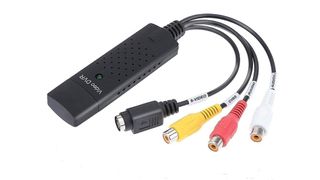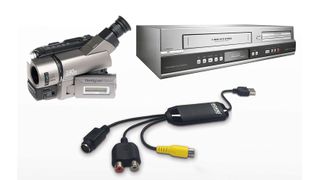With the best VHS to DVD converters, you never have to let your old video recordings gather dust or, worse, fall victim to someone in a cleaning frenzy. (Thanks a lot, mom.) Do the smart thing and preserve those beloved recordings of kids now grown or TV shows long forgotten by converting those bulky and oh-so-fragile tapes to DVDs.
Here’s the best news: Converting VHS recordings to DVD is little more than running an S-video or RCA cable to your VHS player and a USB cable to connect to a PC or Mac. Hook up both devices, insert the VHS tape you want to convert, and the conversion software does the rest.
The best VHS to DVD converters include the software you’ll need to convert from analog to digital, but you can also download third-party software that does the job just as well, if not better. (Definitely check out OBS Studio, which offers a fast and intuitive way to convert VHS tapes.) A useful guide for using OBS Studio to convert VHS to DVD can be found here.
An extra benefit of converting your VHS recordings to DVD is that most converters let you store video on your computer’s hard drive. You can keep your library digital or burn it to DVD, whichever suits your needs. Most newer computers are set up to burn DVDs or Blu-ray discs, but if yours is a little on the older side, we’d recommend using an external DVD drive like the highly affordable Amicool External DVD drive.
But what’s the point of giving your old tapes new life if you’re not going to watch them? Take a look at our guide to the best DVD players and Blu-ray players, as well as the best TVs in 2022.
Finally, VHS tape isn't the only retro technology that can be converted to digital. Our guide to the best cassette to MP3 converters can help you revive and preserve your old cassettes as well.
1. DIGITNOW Video Capture Converter: Best VHS to DVD converter
Why you can trust Top Ten Reviews

The DIGITNOW Video Capture Converter is another solid option if you’re looking for a VHS to DVD converter cable. It features both an s-video and RCA connection which should let you connect to just about any VHS player, while the output connection is a USB that will let you plug directly into your laptops or home computer.
The built-in software that comes with the DIGITNOW Video Capture Converter is on a CD-ROM (how retro), so you’ll need to make sure your computer has a disk drive or you won’t be able to install it (or you could use the OBS Studio software we recommended above).
The majority of users on Amazon have reported that the adapter and software work as claimed, but some users warn that it can be a little slow and clunky.
2. August VGB100 External USB Video Capture Card: Best budget option

If you’re looking to transfer your old media onto your computer then the August VGB100 is a great choice. This VHS to DVD converter offers an S-video or RCA to USB connection to let you connect your old devices, such as a VHS player or older video game console, directly to your home computer.
Unlike some of the products that we’re recommending, the August VGB100 comes with its own integrated software. Many VHS to DVD converters are older technology and struggle to run on modern operating systems like Windows 10, but the August VGB100 is fully Windows 10 compatible.
The August VGB100 has other uses too, as you can use it to record footage from a video game console if you’re looking to upload it to social media or YouTube.
3. Cleantt Video Capture Card: Simplest to use

The Cleantt Video Capture card is another decent option for a VHS to DVD converter at a reasonable price. Like the others on this list, the Cleantt Video Capture Card has a USB connection to plug into your computer and either an S-Video or RCA connection for your old VHS player. Simply plug in the device, install any drivers and software that come with it and you’re good to go.
User reviews have been mostly positive on Amazon, with most reviewers stating that it works as intended, transferring old VHS tapes into a digital format. Some users had issues getting the software to work on their devices though, so again we’d recommend trying more up to date third party software like OBS studio if you have issues.
4. UCEC USB 2.0 Video Capture Card: Great, if you need help

Another option at the higher end of the price range, the UCEC USB 2.0 Video Capture Card offers the same basic products - it’s a cable that connects to your computer via as USB and to your old VHS player via either an S-Video or RCA connection. The bundled software comes on a disc, so if you want to use it you’ll need a home computer or laptop that has a disc drive.
One thing that might help the UCEC stand out is that it offers 24-online technical support and a one year money-back guarantee. This means you should be able to get help from an expert if you’re having trouble getting the software to work.
Some users have noted poor video conversion quality and issues with colors not transferring properly, but the majority of reviews have been positive. Other users have noted that the customer service was responsive and helpful though.
5. Roxio Easy VHS to DVD: An older system

The Roxio Easy VHS to DVD has been on our list of the best VHS to DVD converters for what seems like eons. Sadly this piece of kits hasn’t had an update in quite some time, which has resulted in it slipping down the rankings. As with the other choices on this list, the Roxio Easy VHS to DVD connects to your computer via as USB while plugging into your older devices, like a VHS or camcorder, via an S-Video or RGB connection.
Sadly, users seem to be having mixed results with the Roxio these days. Many users have complained that the software doesn’t work, or only works intermittently which is concerning. As one of the one star reviews on Amazon points out though, the hardware itself works fine - it’s just the bundled in software that sucks. If you’re going to pick up the Roxio, we’d recommend using the free software we mentioned at the beginning of this article instead.
It’s also a little expensive for what is essentially a cable with a signal converter built into it. On the flip side, it comes with two free DVDs, which is something we guess. If it’s all you can find, it’ll do the job but there are cheaper choices out there that work just as well.
What software do you need to convert VHS to DVD?
Many of the best VHS to DVD converters come with their own custom software, which you can simply download/copy to your PC. These will handle the whole process for you, from capturing the footage off your VHS, right through to burning it onto a fresh DVD. Many will help you enhance the quality of your old VHS tapes too, so they won't look quite so dated.
However, not all converters come with their own software, and some people will prefer to use different software other than what's provided. If you're in need of a separate program, we suggest something like Golden Videos from NCH Software, who offer a large range of niche apps to help preserve older media. Alternatively, Easy VHS to DVD is worth a look too. Just be aware that some of these smaller software packages may ask you to install other apps, and in this instance you should never copy something to your PC that you don't trust.
If you want a separate program for copying your files to DVD from your computer, we actually have a guide to the best DVD ripper software - this will both copy files FROM and TO any DVD.
Is copying VHS tapes legal?
Good question. As with copying DVDs to digital formats, the rules are as follows. If the footage is yours and yours alone, and you own the copyright (which you do for any home movie footage captured on a camcorder, for example), then you can make as many copies as you like. You can distribute your DVDs as you see fit too - it's literally your footage.
If you're copying a video of a movie or TV show, then the rules are as follows. It's ok to make a back-up copy of any movie or TV show that you've bought and own, so as long as you have the original, it's ok to copy the video to a DVD or digital file for you to watch and enjoy personally. You can't sell or distribute the copies you make, though, and we'd recommend keeping the original video that you bought too.
For more information, check out our guide on when DVD ripping is illegal.


